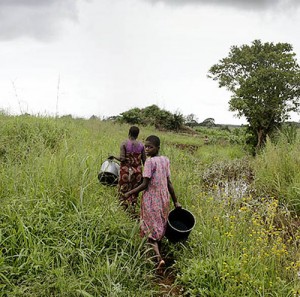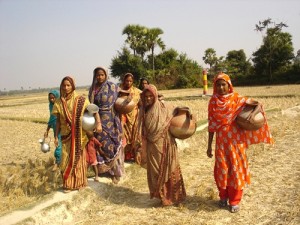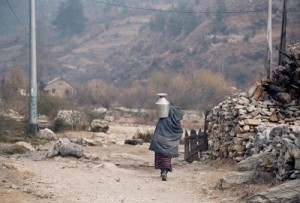It hit me recently that I am one lucky person when it comes to water. This may sound odd to you, but it’s true and a lot of us, particularly women, take this for granted. The most it takes for me to get clean water, is the effort to turn on a faucet or maybe fill up my Brita pitcher for filtered drinking water (and I’m embarrassed to say that sometimes I’m too lazy even for that). So besides the luxury of convenience why am I and so many other women so lucky when it comes to water? Because when we want to drink a glass of water, take a shower or boil pasta we don’t run the risk of being beaten, raped, missing out on education or spending a significant portion of our day on the task.
Women have a special relationship with water, one that is not initially obvious when you think of the two nouns: women and water. Water is both a burden and a source of dignity in women’s lives. In many developing countries women are solely responsible for the collection and management of water, an arduous  and time-consuming task. But most importantly, water provides women opportunities for improved sanitation and hygiene. This helps in reducing the deaths of these women’s children, reducing maternal mortality, and giving women access to private toilet facilities (especially important for girls in school going through puberty). In turn, women are able to lead healthier lives with healthier children and allow more girls to stay in school and receive an education (important in reducing gender inequality and empowering women economically through education).
and time-consuming task. But most importantly, water provides women opportunities for improved sanitation and hygiene. This helps in reducing the deaths of these women’s children, reducing maternal mortality, and giving women access to private toilet facilities (especially important for girls in school going through puberty). In turn, women are able to lead healthier lives with healthier children and allow more girls to stay in school and receive an education (important in reducing gender inequality and empowering women economically through education).
For many women, especially poor, rural women, the risks I mentioned in the first paragraph are a fact of life. This is because water collection in many societies is a highly gendered task still considered “women’s work.” While men are out filling their gender role as the “provider” generating income; women must fulfill their “domestic” role caring for the children, cooking, managing the household and collecting water for the family. This continuous cycle contributes to furthering gender inequalities, loss of  education, exposure to dangerous environments and vulnerability to violence.
education, exposure to dangerous environments and vulnerability to violence.
It is ironic how something as important as providing water for families can so adversely affect women’s lives and health. Water allows a household to function by providing a means to cook, wash clothes, clean and maintain a healthy family. Water is vital to the health of a family and the communities in which they live. You would think that those in charge of managing such a precious commodity would be valued within their families and communities. Sadly, this is not the case.
Fortunately, water and gender equality are prominent issues on the agendas of international development and health organizations. Organizations like the Gender and Water Alliance and UN-Water are dedicated to integrating gendered approaches to water management throughout the world. But organizations must be careful to include community involvement in planning as this is vital to the success of water projects. This means that both genders must be involved in the projects if they are to be successful. Evidence from UN- Water shows that women’s participation in water management planning improves project sustainability, efficiency, increases the economic benefits and better protects resources. However, this can be particularly challenging in developing countries where women lack the chance to be involved in any decision-making within their own governments.
Water shows that women’s participation in water management planning improves project sustainability, efficiency, increases the economic benefits and better protects resources. However, this can be particularly challenging in developing countries where women lack the chance to be involved in any decision-making within their own governments.
Women’s inclusion in water project decision-making will no doubt make strides in gaining gender equality, but to target the issue holistically a multifaceted approach must be taken. There are many more obstacles that must be addressed besides water management. What are some other strategies towards that can be used to shift the norms of inequality within these communities and protect women during water collection?


